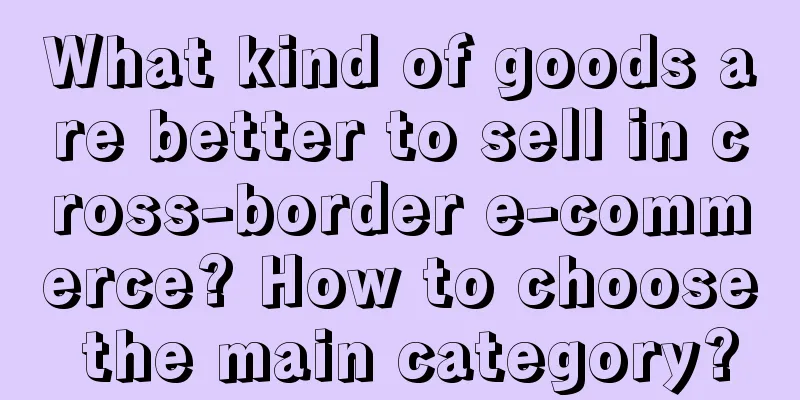What is the transaction process for cross-border e-commerce sellers? What should you pay attention to?

|
Now many people want to start their own business. There are many options for starting a business. Everyone should be interested in cross-border e-commerce. So when you do cross-border e-commerce, the most important thing is to understand the transaction process. What is the transaction process for cross-border e-commerce sellers? What is the transaction process for cross-border e-commerce sellers? 1. Select a cross-border e-commerce platform Cross-border e-commerce platforms are the core of cross-border e-commerce operations, and choosing a good cross-border e-commerce platform is very important. At present, there are many types of cross-border e-commerce platforms in the domestic market, such as Tmall Global, JD Global Shopping, Amazon China, etc. Merchants can choose a platform that suits them according to their needs. 2. Register a cross-border e-commerce platform account Registering a cross-border e-commerce platform account is the first step in cross-border e-commerce. Merchants need to fill in relevant information according to the platform's requirements, such as company name, company registration place, business license, tax registration certificate, etc., so that the platform can review the merchant's qualifications. 3. Apply for an overseas payment account Cross-border e-commerce needs to apply for an overseas payment account in order to conduct cross-border transactions. Merchants can choose from a variety of methods such as Alipay, Paypal, and international credit cards to establish their own overseas payment accounts. 4. Select products There are many kinds of goods on cross-border e-commerce platforms. Merchants can choose suitable goods to sell according to market demand and their own management capabilities. When choosing goods, you need to pay attention to factors such as product quality, price, and supply channels. 5. Purchase of goods Merchants need to purchase goods through various channels. Common channels include domestic wholesale markets, overseas direct mail, overseas purchasing, etc. Merchants need to choose appropriate procurement channels based on their own operating capabilities and market demand. 6. Product stocking Merchants need to prepare the purchased goods to ensure that the goods can be shipped in time. In the process of preparing goods, merchants need to pay attention to factors such as the quality, quantity, and packaging of the goods. 7. Product display Product display is an important means to attract customers. Merchants need to take photos of products, describe them, and display prices in detail so that customers can understand product information. When displaying products, merchants need to pay attention to factors such as the clarity of the pictures and the level of detail of the descriptions. 8. Order processing After a customer places an order, the merchant needs to process the order in a timely manner. The merchant needs to confirm the order information, check the inventory of the goods, arrange the delivery, etc., in order to meet the customer's needs in a timely manner. 9. Logistics and distribution Merchants need to choose a logistics and delivery method that suits them, such as international express, international air transport, sea transport, etc. Merchants need to ensure the timeliness, reliability and safety of logistics and delivery. 10. After-sales service After-sales service is the key for merchants to win the trust of customers. Merchants need to deal with customers' after-sales problems in a timely manner, provide quality assurance, return and exchange services, etc., in order to satisfy customers. This is the end of the introduction to the transaction process for cross-border e-commerce sellers. You can take a look. The most important thing for cross-border e-commerce like this is logistics. For everyone, if the logistics can deliver goods according to the rules, there will be no violations. Recommended reading: How to do cross-border e-commerce live streaming? How to do live streaming? Is cross-border e-commerce authentic and reliable? How to do cross-border e-commerce without a source of goods? How much money can you make in a year doing cross-border e-commerce? What are the risks? |
<<: What should I do if my Meikeduo store is closed? How should I choose products?
>>: What are the advantages of doing business on Amazon in the United States? Is it easy to do?
Recommend
Talk about the changes in commercial bank retail business and private domain practices
For many industries now, private domain building i...
In order to save money, young people started the "mass migration" from Taobao
When Taobao is deeply trapped in inflated prices, ...
Is it good for cross-border e-commerce to do tax accounting? What are the requirements?
With the development of the Internet and the globa...
The experience design that exceeds expectations is a surprise for consumers who pursue low prices!
Sometimes, when we buy low-priced goods, we can al...
Shopee Philippines launches new feature, Seller Services Platform
Shopee Philippines platform announced that it has ...
Why can't I withdraw money from Meikeduo? What are the sites?
When you open a store on an e-commerce platform, u...
Taobao opens up a "new route" to overseas markets, with some clothing sellers earning an extra 200,000 yuan a week
Taobao launched a global free shipping plan for cl...
If you want to make money in your private domain, you must post good Moments
How to make money from private domain traffic? Wha...
How is Amazon's warehouse relocation fee calculated? Detailed answer
When doing business on Amazon, if the merchant'...
Xiaohongshu: Why is it so difficult to “plant grass” overseas?
This article deeply analyzes the difficult process...
Local life live broadcast: from 123 link to 123 boss
With the rise of live streaming, merchants in the ...
How to open multiple sites on eBay? What is the eBay registration process?
Merchants who open stores on eBay will first choos...
What is an Amazon independent promotional code? How to use an independent promotional code?
There are three types of discount codes on Amazon:...
Should a new Shopee store advertise? Tips on how to advertise on Shopee
As a cross-border e-commerce platform, Shopee is v...
What is the return process of Amazon in the United States? What is the return policy?
After shopping on the Amazon platform, if we are n...









